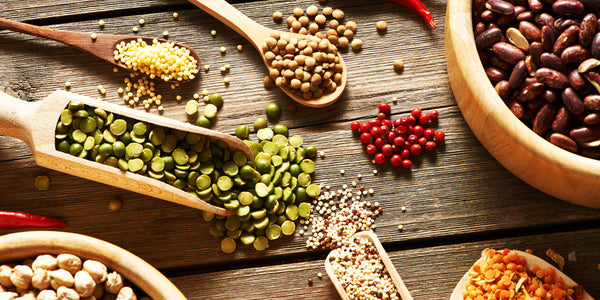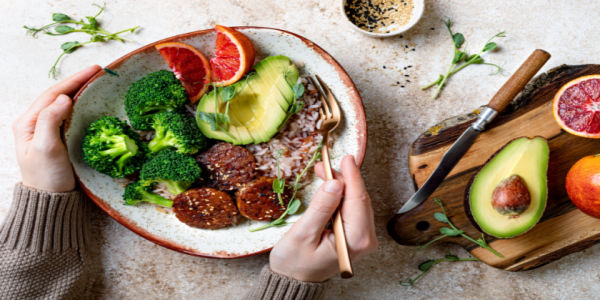
Diets come and go. Some should be considered, while most should be a fad of the past.
Those eating patterns that "make it" are specifically ones that grab the attention of not only diet-seekers, but get the stamp of approval by dietitians and other healthcare professionals. This especially serves true for diets that do not eliminate foods without a warrant. They are also rich in vitamins, minerals, fiber, antioxidants, and other nutrients.
Nutrients are substances that offer nourishment to the body and its cells. They are essential for growth and the maintenance of life. Lectins, however, are known as anti-nutrients. This is a less common term describing plant compounds that may reduce the body's ability to absorb essential nutrients from foods.
But what exactly are dietary lectins and are they really a nutrient of concern? Find out here and which healthy foods they are naturally sourced in. (And if you should be avoiding them!)
What Are Lectins?
Lectins are carb-binding proteins mostly found in plants. They are believed to play defense and protect themselves against animals and insects in nature. Also being indigestible, lectins travel through the gut unchanged.
The concept was brought to light and popularized by Steven Gundry, MD. Dr. Steven Gundry is a cardiothoracic surgeon, heart surgeon, medical researcher, and author. His book, The Plant Paradox, suggests lectins are "the hidden dangers in 'healthy' foods that cause disease and weight gain."
Dr. Gundry believes lectins were not intended to be eaten by humans and should be eliminated in the diet. Lectins are speculated to bind to cells on the gut wall and trigger a response, which is suggested to lead to a number of health problems. These include rheumatoid arthritis, headaches, low energy, allergies, brain fog, and skin problems, just to name a few.
A large intake of lectins may also cause gastrointestinal distress, particularly if consumed in their raw form. Side effects of eating foods high in lectins may include gas, bloating, and diarrhea. Individuals with Crohn's disease or irritable bowel syndrome may be more prone to food lectins, too. This is because the gut lining is more vulnerable and sensitive related to a higher turnover of cells.
Foods High in Lectins
Lectins are found in a wide variety of sources but mostly concentrated in nutritious, whole foods. In fact, most foods high in lectins are ones encouraged to form a balanced diet. These include whole grains, fruits and vegetables, beans and legumes, nuts and seeds, milk and dairy products.
More specifically, lectins are commonly known to be in the following foods:
1. Wheat germ
2. Barley
3. Rice
4. Eggplants
5. Potatoes
6. Tomatoes
7. Garden peas
8. Jack beans
9. Navy beans
10. Lima beans
11. Red kidney beans
12. Soybeans
13. Peanuts
14. Spices (such as peppermint and nutmeg)
Instead of eating this "bad list," Dr. Gundry identifies certain noodles, red wine, and cream cheese on the "good list." Other low-lectin food sources include leafy greens, cruciferous veggies, in-season berries, plant-based oils, nuts and seeds, fresh fish, and pasture-raised poultry.

Dr. Gundry also created the "Lectin Shield," which is a dietary supplement he sells on his website for $79.95 per bottle of 120 capsules. The supplement is advertised as "a unique blend of potent compounds designed to bind to the lectins in your diet." Additional specific claims include:
• Nourish the gut lining (helps prevent "Leaky Gut")
• Form a protective barrier in the GI tract
• Help make bathroom habits more "regular"
• Support the immune system
• Help the body process protein for energy
• Reduce overall appetite
• Help relieve joint discomfort
Or, rethink the product and turn to more economical, proven tips.
Lectin concentration in foods may be reduced through preparation techniques. These include sprouting, soaking, cooking, and fermenting.
Sprouting
Sprouting is a process seeds, grains, beans, and other plant foods undergo when conditions are just right. They essentially emerge from their outer shell after basking in a warm and moist environment for a few days.
Allowing these foods to sprout can help reduce lectin content. In general, the greater the sprouting duration, the lesser the concentration of lectins.
Sprouting may also ease the digestion process and unleash more valuable nutrients, including iron and vitamin C.
Soaking
Soaking raw beans and grains is suggested to minimize lectin content. As a general rule of thumb, soak beans for at least two hours, or overnight if possible.
Adding baking soda and pressure-cooking can also lessen lectin concentration.
Cooking
Cooking high-lectin foods can reduce or completely eliminate the lectin content. Lectins are reduced at a high enough temperature and if cooked long enough.
However, it is also important to not overcook. Generally speaking, overcooking can lead to greater nutrient loss. Cooking too long overall compromises the nutritional value and quality of foods.
Fermenting
Fermentation is the process in which beneficial bacteria are able to reduce harmful substances in the body. Sauerkraut, yogurt, tempeh, and kombucha are well-known food sources that undergo the fermentation process.
The fermentation process has shown to reduce lectin content up to 95 percent.
So, Are Lectin Foods In or Out?
To date, researchers do not have clear data regarding their effects on the body. However, there is some evidence suggesting high intakes of raw lectin foods can "seriously threaten the health of consuming animals."
Most of the foods are not consumed in their raw form in mass quantities, anyways. And once soaked and cooked, the lectin in food is significantly reduced. Evidence is scarce to nonexistent, too, in human studies. Most advertised benefits of ridding foods high in lectins are based on testimonials displayed on the official Dr. Gundry website.
Ultimately, the lectin food list as a whole is incredibly beneficial. All mentioned foods high in lectin are rich in vitamins, minerals, antioxidants, and other nutrients with extensive health benefits. The plant foods are also especially of value to increase plant-based protein, especially if reducing animal meats and products.
Most nutrition experts suggest consuming a variety of foods and balanced meals limits the risk of nutritional deficiencies. Eating a nutritious diet can also naturally lead to long-term weight loss and lower the risk of other chronic diseases.
If interested in or following a specific diet, consult with a dietitian or other healthcare professional first. This is especially true if managing a chronic health condition. Or, if single or multiple food groups are restricted or eliminated as in some diet recommendations. Their expertise and guidance can help determine whether or not following a lectin-free diet may be right for you.







